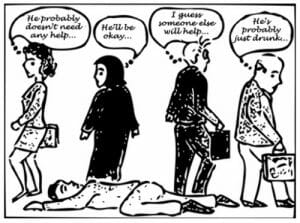Bystander Effect Definition
Bystander effect, also called bystander apathy, is a term in psychology that refers to the tendency of people to take no action in an emergency situation when there are others present. This concept was popularized after the 1964 killing of Kitty Genovese in New York City, giving rise to the term, “Genovese Syndrome”. The term bystander effect was coined in 1969 by John Darley and Bibb Latane to refer to the effect of certain social pressures on emergency responses in people.

The figure depicts individuals engaged in bystander apathy
History
On March 13 1964, 28-year old Kitty Genovese was returning to her apartment in the Queens neighborhood of New York City when she was attacked by Winston Moseley. Moseley raped and stabbed Genovese to death outside her apartment while 38 people looked on and did nothing. The police were called, but dismissed the call as a “domestic dispute”. The national media picked up the story and public outrage towards the onlookers mounted.
In 1969, five years after the murder, social psychologists Bibb Latane and John Darley published “Bystander ‘Apathy’” in American Scientist. In this work, they conducted four separate experiments to test the effects of social interaction in emergency response. The experiments placed subjects in a situation where a minor emergency event was taking place, and correlated their response to the actions of confederates to the experiment in the room. The outcome of the experiments showed that there are social factors that influence three different emergency management decisions. The first is that an emergency is perceived, second is what appropriate action is to be taken, and third is that social pressures exist to deter people from taking appropriate action in an emergency.
Bystander Effect Examples and Experiments
In the event of an emergency, the first decision that a person needs to make is whether or not an emergency actually exists. This decision, when the individual is alone, is based on past experience and training. However, Latane and Darley concluded that in the presence of others, individuals will have a tendency to look to others for the correct decision. Seeing the inaction of others can develop a pluralistic response, causing a group to delay or fail to take action. Additionally, seeing the inaction of others can cause people to perceive the situation as less serious than it actually is.
The second decision that a person needs to make when an emergency situation is determined is what the appropriate course of action is. When there is a group of people also present, the responsibility of an individual person is lesser. In this situation, each individual in a large group may feel responsible it is not their responsibility to act first. In order for a person to act first, they must assume a higher level of personal responsibility than their share.
The third decision component of emergency response is once the appropriate course of action is determined; often the individual struggles with situational factors that inhibit them from acting. Latane and Darley showed in their experiments that individuals in the presence of strangers are far less likely to act than people in the presence of friends. Additionally, people who have even briefly met the victim are much more likely to respond.
The bystander effect has found a place in social psychology to explain the cumulative effects of several social tendencies during the occurrence of an emergency. The term “bystander apathy” is considered incorrect, since it was determined during the experiments that the subjects experienced genuine concern. However, this term remains widely used in news outlets for dramatic effect.
Quiz
1. In what year was the term “bystander apathy” first used in an academic paper?
A. 1969
B. 1964
C. 1999
D. 1938
2. Which decision is not part of emergency response in an individual?
A. Deciding if there is an emergency
B. Deciding if it is the individual’s responsibility to act
C. Deciding appropriate action
D. Deciding if response was too severe
3. What factor is associated with an increased emergency response in an individual?
A. Sex of the victim
B. Sex of the individual
C. Familiarity of the victim to the individual
D. Increase in number of unfamiliar witnesses
References
- Bystander Effect. (n.d.). Retrieved May 04, 2017, from https://www.psychologytoday.com/basics/bystander-effect
- Nehme, F. S. (2016, June 02). Kitty Genovese murder doc recalls the infamous crime. Retrieved May 04, 2017, from http://nypost.com/2016/06/02/kitty-genovese-murder-doc-recalls-the-infamous-crime/
- Kilgannon, C. (2016, April 06). Queens Neighborhood Still Haunted by Kitty Genovese’s Murder. Retrieved May 04, 2017, from https://www.nytimes.com/2016/04/07/nyregion/queens-neighborhood-still-haunted-by-kitty-genoveses-murder.html
- Darley, J., & Latane, B. (1969). Bystander “Apathy”. American Scientist, 57, 244-268. Retrieved May 04, 2017.
Bystander Effect
No comments:
Post a Comment